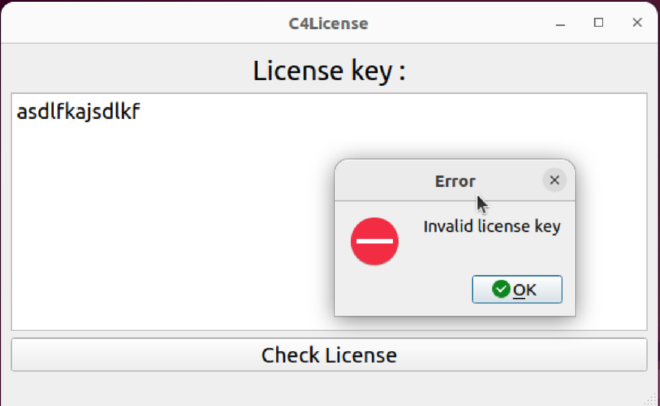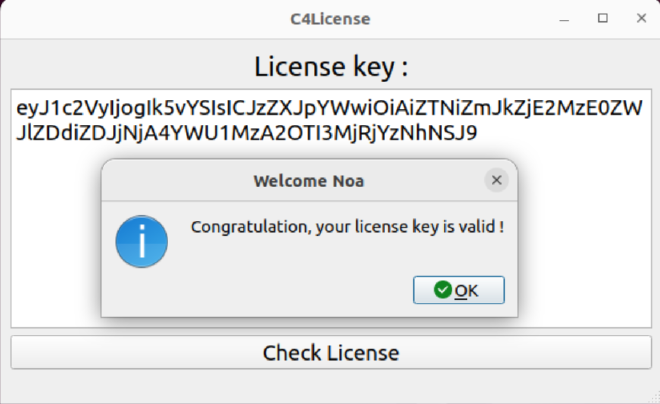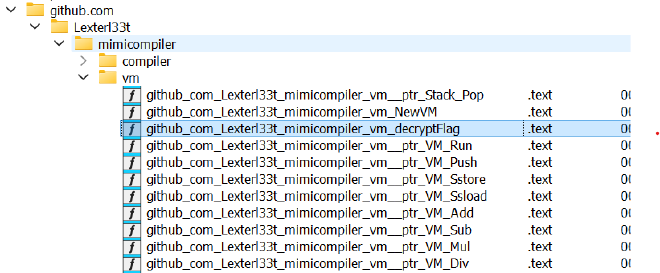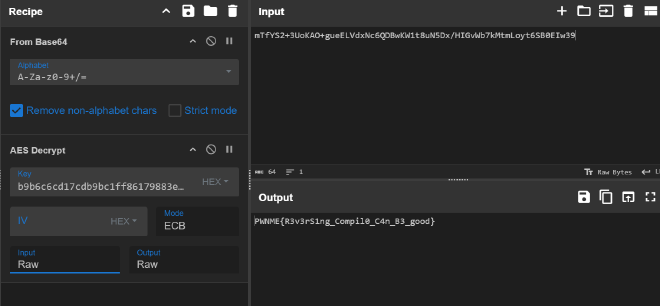Overview #
Here are some of the challenges that I solved during PwnMe CTF 2025:
Rev #
Back to the past #
Using the provided binary and the encrypted file, find a way to retrieve the flag contained in “flag.enc”. Note that the binary would have been run in May 2024. Note: The flag is in the format PWNME{…}
Author :
FayredFlag format:
PWNME{.........................}
We are given a binary executable that encrypts the flag file.
eenosse@ITDOLOZI:~/pwnmeCTF_2025/rev_Back_to_the_past$ ./backToThePast
Usage: ./backToThePast <filename>
eenosse@ITDOLOZI:~/pwnmeCTF_2025/rev_Back_to_the_past$ echo 1234 > test
eenosse@ITDOLOZI:~/pwnmeCTF_2025/rev_Back_to_the_past$ ./backToThePast test
time : 1740925301
Running the binary, we see that it prints out the current timestamp. So it might use the timestamp for encryption. Let’s check that in IDA:
Click to expand
int __fastcall main(int argc, const char **argv, const char **envp)
{
char v3; // cl
int v5; // edx
char v6; // cl
int v7; // edx
char v8; // cl
int v9; // eax
char v10; // cl
int v11; // [rsp+1Ch] [rbp-124h]
unsigned int v12; // [rsp+20h] [rbp-120h]
__int64 v13; // [rsp+28h] [rbp-118h]
char v14[264]; // [rsp+30h] [rbp-110h] BYREF
unsigned __int64 v15; // [rsp+138h] [rbp-8h]
v15 = __readfsqword(0x28u);
if ( argc > 1 )
{
v12 = time(0LL, argv, envp);
printf((unsigned int)"time : %ld\n", v12, v5, v6);
srand(v12);
v13 = fopen64(argv[1], "rb+");
if ( v13 )
{
while ( 1 )
{
v11 = getc(v13);
if ( v11 == 0xFFFFFFFF )
{
break;
}
fseek(v13, 0xFFFFFFFFFFFFFFFFLL, 1LL);
v9 = rand();
fputc(v11 ^ (unsigned int)(v9 % 0x7F), v13);
}
fclose(v13);
strcpy(v14, argv[1]);
strcat(v14, ".enc");
if ( (unsigned int)rename(argv[1], v14) )
{
printf(
(unsigned int)"Can't rename %s filename to %s.enc",
(unsigned int)argv[1],
(unsigned int)argv[1],
v10);
return 1;
}
else
{
return 0;
}
}
else
{
printf((unsigned int)"Can't open file %s\n", (unsigned int)argv[1], v7, v8);
return 1;
}
}
else
{
printf((unsigned int)"Usage: %s <filename>\n", (unsigned int)*argv, (_DWORD)envp, v3);
return 1;
}
}
Indeed, it uses the timestamp to set seed, then XOR our file with random numbers and write it to a .enc file.
Things should be easy enough. However, when I tried to write a solve script using libc’s random, it didn’t give the right result. After debugging, I noticed that the random numbers of the program were different from mine. So something has been changed 🤔.
It turns out the srand and rand functions are not the standard libc functions, but rather custom functions:
__int64 __fastcall srand(int a1)
{
__int64 result; // rax
result = (unsigned int)(a1 - 1);
seed = result;
return result;
}
unsigned __int64 rand()
{
seed = 0x5851F42D4C957F2DLL * seed + 1;
return (unsigned __int64)seed >> 0x21;
}
The srand function actually sets the seed to be equal to a1 - 1. I’m not sure if rand is different from the standard one, but we’ll not care about that.
From this, I wrote a quick script to solve the challenge. Given that the challenge’s description said the binary would have been run in May 2024, I bruteforced the timestamp from May to June:
data = open("flag.enc", 'rb').read()
seed = 1740845724
def srand(s):
global seed
seed = s - 1
def rand():
global seed
seed = (0x5851F42D4C957F2D * seed + 1) & 0xffffffffffffffff
return seed >> 0x21
for t in range(1714521600, 1717200000):
srand(t)
msg = []
for c in data:
rand_num = rand()
msg.append(c ^ (rand_num % 0x7f))
msg = bytes(msg)
if b"PWNME" in msg:
print(msg)
Running this will give us the flag: PWNME{4baf3723f62a15f22e86d57130bc40c3}
C4 License #
Using the license of ‘Noa’ and the provided binary, develop a keygen to create a valid license for the 100 requested users.
Author :
FayredFlag format:
PWNME{.........................}Connect :
nc --ssl [Host] 443
We are given two files: A binary executable and a sample license for a user named Noa.
Running the binary will show us a form. Typing in an invalid license, we’ll get Invalid license key. If we use the sample license, we’ll get Congratulation, your license key is valid !


There are a lot of functions, so it might be a good idea to look for the string Invalid license key in the file.
Ctrl+F for IDA 9.0, or Alt+T for older versions.
We can see that it’s used in the function C4License::on_checkKey_clicked. This function will base64 decrypt our license and get user and serial from the decrypted JSON string. These will be passed to the checker function, which checks the values as follows:
- First, it uses the
crc32checksum ofuser(which isa1) to set the seed throughsrand. Then, it generates two random numbers to make the keyv26, which is used as the key for RC4 decryption:
v3 = *((unsigned int *)a1 + 2);
v4 = *a1;
v27 = __readfsqword(0x28u);
v5 = crc32(0LL, v4, v3);
srand(v5);
v6 = rand();
*(_DWORD *)v26 = _byteswap_ulong(rand() % 0xFFFF * (v6 % 0xFFFF));
RC4::RC4((RC4 *)v25, v26);
- After that, it will hex decode the
serial(a2) and RC4 decrypt it using the key above. The result will be stored inv22
RC4::RC4((RC4 *)v25, v26);
QByteArray::fromHex((QByteArray *)&v24, a2);
RC4::decrypt(&v22, v25, &v24);
- Finally, it will compare the SHA1 checksum of
v22and compare it withb039d6daea04c40874f80459bff40142bd25b995.
The hash is not crackable, but through debugging using the sample license, we see that v22 is PwNmE_c4_message!137.
From this, we can write a script that takes 100 username from the server and generate the licenses:
Show solve script
from base64 import b64encode, b64decode
from Crypto.Cipher import ARC4
from ctypes import CDLL
from zlib import crc32
from pwn import *
import time
libc = CDLL("libc.so.6")
def gen_license(username):
username = username.encode()
seed = crc32(username)
print(hex(seed))
libc.srand(seed)
n1 = libc.rand()
n2 = libc.rand()
n = (n1 % 0xffff) * (n2 % 0xffff)
print(hex(n))
rc4_key = bytes.fromhex(hex(n).replace("0x", '').zfill(8))
print("key:" , rc4_key.hex())
rc4 = ARC4.new(rc4_key)
enc = rc4.encrypt(b"PwNmE_c4_message!137")
password = enc.hex()
license = f'{{"user":"{username.decode()}","serial":"{password}"}}'
print(license)
return b64encode(license.encode()).decode()
# print(gen_license("Noa").decode())
p = remote("c4license-90c9d36428b43675.deploy.phreaks.fr", 443, ssl=True)
# context.log_level = 'debug'
for i in range(100):
msg = p.recvuntil(b"user :").decode()
print(msg)
username = msg.split("Your license for ")[1].split(" user")[0].strip()
print(username)
license = gen_license(username)
p.sendline(license.encode())
time.sleep(0.5)
p.interactive()
Mimirev #
A new and obscure programming language, MimiLang, has surfaced. It runs on a peculiar interpreter, but something about it feels… off. Dive into its inner workings and figure out what’s really going on. Maybe you’ll uncover something unexpected.
Author :
Lxt3hFlag format:
PWNME{.........................}
We are given a binary executable which runs the code in a .mimi file. Let’s look in IDA!
It seems like it’s a Golang binary. When analysing a non-stripped Golang or Rust file, the first thing that I do is looking for interesting function names:

Well look at that, there is a github_com_Lexterl33t_mimicompiler_vm_decryptFlag function. And it’s used by github_com_Lexterl33t_mimicompiler_vm__ptr_VM_VerifyProof.
Analysing the function, we see that the function does the following:
- It pops two values
xandyfrom the stack and checks some constraints:
x + y == 314159
(x * x + y * y * y - x * y) % 1048573 == 273262
- If
xandysatisfy the constraints, they will be formatted as%d:%d. Then the function takes the SHA256 sum of this to decrypt the flag usinggithub_com_Lexterl33t_mimicompiler_vm_decryptFlag:
v30 = runtime_convT64(x, v24, v25, 1, 1, v26, v27, v28, v29, v69);
*(_QWORD *)&v93 = "\b";
*((_QWORD *)&v93 + 1) = v30;
v36 = runtime_convT64(y, v24, v31, 1, 1, v32, v33, v34, v35, v70);
*(_QWORD *)&v94 = "\b";
*((_QWORD *)&v94 + 1) = v36;
v41 = fmt_Sprintf((unsigned int)"%d:%d", 5, (unsigned int)&v93, 2, 2, v37, v38, v39, v40, v71, v76, v79, v84);
v46 = runtime_stringtoslicebyte((unsigned int)&v87, v41, 5, 2, 2, v42, v43, v44, v45, v72, v77, v80);
crypto_sha256_Sum256(v46, v41, v47, 2, 2, v48, v49, v50, v51, v73, v81, v85);
v86[0] = v74;
v86[1] = v82;
v52 = a1[8];
v56 = github_com_Lexterl33t_mimicompiler_vm_decryptFlag(
(__int64)a1[7],
(signed __int64)v52,
(__int64)a1[9],
(__int64)v86,
16LL,
32,
v53,
v54,
v55);
I will not try to explain github_com_Lexterl33t_mimicompiler_vm_decryptFlag fully, but it seems like the SHA256 checksum is used as the key for AES decryption (the first 16 bytes). So what is being decrypted here?
We haven’t even looked at the main function yet. In the main function, there is a part where it creates a new VM:
v170 = github_com_Lexterl33t_mimicompiler_vm_NewVM(
v79,
(_DWORD)v52,
v80,
(unsigned int)"mTfYS2+3UoKAO+gueELVdxNc6QDBwKW1t8uN5Dx/HIGvWb7kMtmLoyt6SB0EIw39",
64,
(unsigned int)"11466b4b07a438fdba619b86088353976073d790344cbf4dae99512028808ecf",
64,
v83,
v84,
v125,
v136,
v143,
v149,
v153,
v154);
Looking at this function, there are some interesting stuffs:
__int64 __golang github_com_Lexterl33t_mimicompiler_vm_NewVM(
__int64 a1,
__int64 a2,
__int64 a3,
__int64 sus_base64,
int _64,
__int64 sus_hex,
__int64 _64__,
int a8,
int a9)
{
// variables ...
v30 = encoding_base64__ptr_Encoding_DecodeString(
qword_5A57B8,
sus_base64,
_64,
sus_base64,
_64,
sus_hex,
_64__,
a8,
a9);
// ...
if ( dword_5C5970 )
{
result = runtime_gcWriteBarrier4();
v23 = a1;
*v27 = a1;
v24 = v31;
v27[1] = v31;
base64_decrypted = v30;
v27[2] = v30;
sus_hex_ = sus_hex;
v27[3] = sus_hex;
}
else
{
v23 = a1;
v24 = v31;
base64_decrypted = v30;
sus_hex_ = sus_hex;
}
*(_QWORD *)(result + 24) = v23;
*(_QWORD *)(result + 48) = v24;
*(_QWORD *)(result + 64) = sus_base64;
*(_QWORD *)(result + 72) = v28;
*(_QWORD *)(result + 56) = base64_decrypted;
*(_QWORD *)(result + 88) = _64__;
*(_QWORD *)(result + 80) = sus_hex_;
return result;
}
We can see that base64 string is decrypted and stored in result[7] (result + 56). Looking back at github_com_Lexterl33t_mimicompiler_vm_decryptFlag, we can see that this is used as the first argument. The hex string isn’t used in this function tho, so maybe it’s AES ECB.
With the informations that we have, let’s try to decrypt the flag! First, we need to find x and y. We can write a quick script to brute-force the solution:
from hashlib import sha256
for x in range(314159+1):
y = 314159 - x
if (x * x + y * y * y - x * y) % 1048573 == 273262:
key = f"{x}:{y}"
hash = sha256(key.encode()).hexdigest()
print(key)
123456:190703 b9b6c6cd17cdb9bc1ff86179883e65116555b6766df2498281cd331366eae5d3
206712:107447 82bd2f75c8fb42d505bbd5b97b0d110f67f493ff74b16d247abbf34f01276459
We get two keys. Trying each key (the first 16 bytes), we can see that the first one gives the flag:

Super secure network #
I actually did this challenge with my friends jitensha69 and severus. You can see severus’s writeup for this challenge here
Misc #
Decode Runner #
Welcome to Decode Runner ! You will receive 100 encoded words. Your goal is to decode them and send back the decoded word. You have 3 seconds to respond to each word. Good luck!
Author :
OffpathFlag format:
PWNME{.........................}Connect :
nc --ssl [host] 443
I did this challenge with my friend KangTheConq. There are a lot of ciphers used here (about 10 ciphers). Let’s walk through each of them:
- Latin Gibberish Cipher:
hint: what is this charabia ???
cipher: siruosus
I asked GPT and it said that charabia is gibberish in French. Googling gibberish cipher returns Latin Gibberish Cipher. It basically reverses the word and add some suffix.
To decrypt this, just remove the last two letters and reverse the string:
def latin_gibberish(s):
data = s[:-2]
return data[::-1]
- Wabun code (Japanese Morse):
hint: It looks like Morse code, but ...
cipher: f .- g
At first, it seems like this is just Morse code. But when submitting the decoded word, the server saids wrong answer.
So what kind of Morse code is this? Turns out, there is another Morse code type named Wabun code. It encode Japanese words using Morse code. I wrote a dirty script to decrypt this (This might not always return the correct result, but it works lol):
Show script
def wabi_sabi(ciphertext):
qod6 = {
# Row 1
"A": "--.--",
"I": ".-",
"U": "..-",
"E": "-.---",
"O": ".-...",
"N": ".-.-.",
# Row 2
"KA": ".-..",
"KI": "-.-..",
"KU": "...-",
"KE": "-.--",
"KO": "----",
# Row 3
"SA": "-.-.-",
"SHI": "--.-.",
"SU": "---.-",
"SE": ".---.",
"SO": "---.",
# # Row 4
# "ZA": "-.-.",
# "ZI": "-.--",
# "ZU": "..--",
# "ZE": ".--.",
# "ZO": "---.",
# Row 5
"TA": "-.",
"CHI": "..-.",
"TSU": ".--.",
"TE": ".-.--",
"TO": "..-..",
# # Row 6
# "DA": "-.",
# "DI": "----",
# "DU": "--.-",
# "DE": "-..-",
# "DO": "--..",
# Row 7
"NA": ".-.",
"NI": "-.-.",
"NU": "....",
"NE": "--.-",
"NO": "..--",
# Row 8
"HA": "-...",
"HI": "--..-",
"FU": "--..",
"HE": ".",
"HO": "-..",
# # Row 9
# "BA": ".-..-",
# "BI": ".-...",
# "BU": "..-..",
# "BE": "....",
# "BO": ".--..",
# # Row 10
# "PA": ".-..-",
# "PI": ".-...",
# "PU": "..-..",
# "PE": "....",
# "PO": ".--..",
# Row 11
"MA": "-..-",
"MI": "..-.-",
"MU": "-",
"ME": "-...-",
"MO": "-..-.",
# Row 12
"YA": ".--",
"YU": "-..--",
"YO": "--",
"RA": "...",
"RI": "--.",
"RU": "-.--.",
"RE": "---",
"RO": ".-.-",
"WA": "-.-",
"WI": ".-..-",
"WE": ".--..",
"WO": ".---",
}
DICT = {}
for key, value in qod6.items():
DICT[value] = key
ciphertext = ciphertext.split()
ans = ''
for word in ciphertext:
if '.' in word or '-' in word:
ans += DICT[word]
else:
ans += word
return ans.lower()
- First Letter:
cipher: India Golf Uniform Alfa November Oscar Delta Oscar November
There isn’t a hint for this one. We can solve this by taking the first letter of each word to form a new word:
def first_letter(s):
s = s.split()
s = [i[0] for i in s]
s = "".join(s)
return s.lower()
- Chord cipher:
hint: Hendrix would have had it...
cipher: x24442 x02220 xx0232 320003 022100 xx0232
A quick Google shows that Jimi Hendrix is an American guitarist and songwriter. Moreover, the cipher looks like guitar chord, so this might be Chord cipher:
def chord_cipher(ciphertext):
ciphertext = ciphertext.split()
dict = {"x02220": 'a', "224442":'b', '032010':'c', 'xx0232':'d', '022100':'e', '133211':'f', '320003':'g', 'x24442':'b', 'x32010':'c'}
ans = ''
for i in ciphertext:
ans += dict.get(i, '?')
return ans
- Baudot Code
hint: He can't imagine finding himself in CTF 150 years later...
cipher: 01111 11000 00011 10010 00011
This looks like Morse code, but each “word” is only 5-digit long. A quick ChatGPT gives Baudot Code:
baudot_table = {
"00000": "null", "00100": " ", "10111": "Q", "10011": "W",
"00001": "E", "01010": "R", "10000": "T", "10101": "Y",
"00111": "U", "00110": "I", "11000": "O", "10110": "P",
"00011": "A", "00101": "S", "01001": "D", "01101": "F",
"11010": "G", "10100": "H", "01011": "J", "01111": "K",
"10010": "L", "10001": "Z", "11101": "X", "01110": "C",
"11110": "V", "11001": "B", "01100": "N", "11100": "M",
"01000": "CR", "00010": "LF", "11011": "Switch to Digits"
}
def baudot_decode(ciphertext):
bits = ciphertext.split()
decoded_text = "".join(baudot_table.get(bit, "?") for bit in bits)
return decoded_text.lower()
- Trimethius Cipher:
hint: Born in 1462 in Germany...
cipher: rmxksmc
Googling the hint gives Johannes Trithemius. Googling the cipher gives Trimethius Cipher.
We can use Try all shifts (bruteforce) on dcode and we’ll see that offset +3 gives meaningful words. I wrote a script for this:
def trimethius_decode(ciphertext):
ALPHABET = "ABCDEFGHIJKLMNOPQRSTUVWXYZ".lower()
offset = 3
ans = ""
for i in range(len(ciphertext)):
idx = ALPHABET.index(ciphertext[i])
ans += ALPHABET[(idx - offset + len(ALPHABET)) % len(ALPHABET)]
offset += 1
return ans
- Chuck Norris Unary Code
hint: He can snap his toes, and has already counted to infinity twice ...
cipher: 0 0000 00 000 0 0000 00 00 0 000 00 0 0 00 00 00 0 00 00 0 0 000000 00 000 0 0000 00 0 0 0000000 00 0000 0 00 00 00 0 0 00 0 0 0
My friend KangTheConq found out that this is Chuck Norris Unary Code, and he writes the decoding script too:
def decode_chuck_norris(unary_code):
parts = unary_code.split()
binary_string = ""
for i in range(0, len(parts), 2):
bit = '1' if parts[i] == '0' else '0'
binary_string += bit * len(parts[i + 1])
decoded_text = ""
for i in range(0, len(binary_string), 7):
decoded_text += chr(int(binary_string[i:i+7], 2))
return decoded_text
- Shankar Speech Defect
hint: Did you realy see slumdog millionaire ?
cipher: PJWX
Googling slumdog millionaire cipher gives Shankar Speech Defect. It’s just another substitution cipher:
def slumdog(ciphertext):
cipheralphabet = 'XWYAZBCDQEFGHIKLMNOPJRSTUV'
plainalphabet = string.ascii_uppercase
plaintext = ''
for c in ciphertext:
if c == ' ':
p = ' '
else: p = plainalphabet[cipheralphabet.index(c)]
plaintext += p
return plaintext.lower()
- Morbit Cipher:
hint: A code based on pairs of dots and dashes. Think of a mix of Morse code and numbers... (AZERTYUIO)
cipher: 2557122917522
KangTheConq clutched again and found out that this is Morbit Cipher:
MORSE_CODE_DICT = {'..-': 'U', '--..--': ', ', '....-': '4', '.....': '5', '-...': 'B', '-..-': 'X',
'.-.': 'R', '--.-': 'Q', '--..': 'Z', '.--': 'W', '-..-.': '/', '..---': '2',
'.-': 'A', '..': 'I', '-.-.': 'C', '..-.': 'F', '---': 'O', '-.--': 'Y', '-': 'T',
'.': 'E', '.-..': 'L', '...': 'S', '-.--.-': ')', '..--..': '?', '.----': '1',
'-----': '0', '-.-': 'K', '-..': 'D', '----.': '9', '-....': '6', '.---': 'J',
'.--.': 'P', '.-.-.-': '.', '-.--.': '(', '--': 'M', '-.': 'N', '....': 'H',
'---..': '8', '...-': 'V', '--...': '7', '--.': 'G', '...--': '3', '-....-': '-'}
MORBIT = ['..', '. ', ' -', ' ', '-.', '--', ' .', '- ', '.-']
KEY = "AZERTYUIO" # Given key
# Map digits to Morbit symbols using the key
MORBIT_CODE_DICT = dict(zip("123456789", MORBIT))
def morse(ciphertxt):
""" Decodes a Morse code string to plaintext. """
plaintxt = ''
for word in ciphertxt.strip().split(" "):
for c in word.strip().split(" "):
if c in MORSE_CODE_DICT:
plaintxt += MORSE_CODE_DICT[c]
plaintxt += ' '
return plaintxt.strip()
def morbit(ciphertxt):
""" Decodes a Morbit cipher text into Morse code, then to plaintext. """
morsetxt = "".join(MORBIT_CODE_DICT[c] for c in ciphertxt if c in MORBIT_CODE_DICT)
return morse(morsetxt).lower()
Combining all of this, we get this final script:
Show script
from pwn import *
import string
HOST = 'decoderunner-6bf56818dcc9ea04.deploy.phreaks.fr'
PORT = 443
p = remote(HOST, PORT, ssl=True)
# p = remote(HOST, PORT)
def latin_gibberish(s):
data = s[:-2]
return data[::-1]
def decode_1337(s):
leet_dict = {
'4': 'A', '/\\': 'A', '@': 'A', '/-\\': 'A',
'8': 'B', '|3': 'B', '13': 'B',
'(': 'C', '<': 'C', '[': 'C', '©': 'C',
'[)': 'D', '|>': 'D', '|)': 'D',
'3': 'E', '€': 'E', '[-': 'E',
'|=': 'F', '/=': 'F',
'6': 'G', '(_+': 'G',
'#': 'H', '/-/': 'H', '[-]': 'H', ']-[': 'H', ')-(': 'H', '(-)': 'H', '|-|': 'H',
'1': 'I', "1'": 'I', '!': 'I', '|': 'I',
'_|': 'J', '_/': 'J',
'|<': 'K', '|{': 'K',
'|_': 'L', '[': 'L', '£': 'L', '1_': 'L',
'|V|': 'M', '|\/|': 'M', '/\/\\': 'M', '/V\\': 'M',
'|\|': 'N', '/\/': 'N', '[\]': 'N', '/V': 'N',
'[]': 'O', '0': 'O', '()': 'O', '<>': 'O',
'|*': 'P', '|o': 'P', '|°': 'P', '/*': 'P',
'()_': 'Q', '0_': 'Q', '°|': 'Q', '(_,)': 'Q',
'|?': 'R', '®': 'R', '|2': 'R',
'5': 'S', '$': 'S', '§': 'S',
'7': 'T', '†': 'T', '¯|¯': 'T',
'(_)': 'U', '|_|': 'U', 'µ': 'U',
'\/': 'V', '|/': 'V',
'\/\/': 'W', 'vv': 'W', '\^/': 'W', '\|/': 'W', '\_|_/': 'W',
'><': 'X', ')(': 'X',
'`/': 'Y', '¥': 'Y', '\/': 'Y',
"7_'": 'Z', '>_': 'Z', '≥': 'Z'
}
result = s
for leet, char in sorted(leet_dict.items(), key=lambda x: -len(x[0])):
result = result.replace(leet, char)
return result.lower()
def slumdog(ciphertext):
cipheralphabet = 'XWYAZBCDQEFGHIKLMNOPJRSTUV'
plainalphabet = string.ascii_uppercase
plaintext = ''
for c in ciphertext:
if c == ' ':
p = ' '
else: p = plainalphabet[cipheralphabet.index(c)]
plaintext += p
return plaintext.lower()
def weird_morse(s):
MORSE_CODE_DICT = { 'A':'.-', 'B':'-...',
'C':'-.-.', 'D':'-..', 'E':'.',
'F':'..-.', 'G':'--.', 'H':'....',
'I':'..', 'J':'.---', 'K':'-.-',
'L':'.-..', 'M':'--', 'N':'-.',
'O':'---', 'P':'.--.', 'Q':'--.-',
'R':'.-.', 'S':'...', 'T':'-',
'U':'..-', 'V':'...-', 'W':'.--',
'X':'-..-', 'Y':'-.--', 'Z':'--..',
'1':'.----', '2':'..---', '3':'...--',
'4':'....-', '5':'.....', '6':'-....',
'7':'--...', '8':'---..', '9':'----.',
'0':'-----', ', ':'--..--', '.':'.-.-.-',
'?':'..--..', '/':'-..-.', '-':'-....-',
'(':'-.--.', ')':'-.--.-'}
MORSE_CODE_DICT_DECODE = {}
for key, value in MORSE_CODE_DICT.items():
MORSE_CODE_DICT_DECODE[value] = key
ans = ""
s = s.split()
for c in s:
if "-" in c or "." in c:
c = c.replace("-", '#').replace(".", '-').replace("#", '.')
ans += MORSE_CODE_DICT_DECODE[c]
else:
ans += c
return ans
def first_letter(s):
s = s.split()
s = [i[0] for i in s]
s = "".join(s)
return s.lower()
def decode_chuck_norris(unary_code):
parts = unary_code.split()
binary_string = ""
for i in range(0, len(parts), 2):
bit = '1' if parts[i] == '0' else '0'
binary_string += bit * len(parts[i + 1])
decoded_text = ""
for i in range(0, len(binary_string), 7):
decoded_text += chr(int(binary_string[i:i+7], 2))
return decoded_text
MORSE_CODE_DICT = {'..-': 'U', '--..--': ', ', '....-': '4', '.....': '5', '-...': 'B', '-..-': 'X',
'.-.': 'R', '--.-': 'Q', '--..': 'Z', '.--': 'W', '-..-.': '/', '..---': '2',
'.-': 'A', '..': 'I', '-.-.': 'C', '..-.': 'F', '---': 'O', '-.--': 'Y', '-': 'T',
'.': 'E', '.-..': 'L', '...': 'S', '-.--.-': ')', '..--..': '?', '.----': '1',
'-----': '0', '-.-': 'K', '-..': 'D', '----.': '9', '-....': '6', '.---': 'J',
'.--.': 'P', '.-.-.-': '.', '-.--.': '(', '--': 'M', '-.': 'N', '....': 'H',
'---..': '8', '...-': 'V', '--...': '7', '--.': 'G', '...--': '3', '-....-': '-'}
MORBIT = ['..', '. ', ' -', ' ', '-.', '--', ' .', '- ', '.-']
KEY = "AZERTYUIO" # Given key
# Map digits to Morbit symbols using the key
MORBIT_CODE_DICT = dict(zip("123456789", MORBIT))
def morse(ciphertxt):
""" Decodes a Morse code string to plaintext. """
plaintxt = ''
for word in ciphertxt.strip().split(" "):
for c in word.strip().split(" "):
if c in MORSE_CODE_DICT:
plaintxt += MORSE_CODE_DICT[c]
plaintxt += ' '
return plaintxt.strip()
def morbit(ciphertxt):
""" Decodes a Morbit cipher text into Morse code, then to plaintext. """
morsetxt = "".join(MORBIT_CODE_DICT[c] for c in ciphertxt if c in MORBIT_CODE_DICT)
return morse(morsetxt).lower()
baudot_table = {
"00000": "null", "00100": " ", "10111": "Q", "10011": "W",
"00001": "E", "01010": "R", "10000": "T", "10101": "Y",
"00111": "U", "00110": "I", "11000": "O", "10110": "P",
"00011": "A", "00101": "S", "01001": "D", "01101": "F",
"11010": "G", "10100": "H", "01011": "J", "01111": "K",
"10010": "L", "10001": "Z", "11101": "X", "01110": "C",
"11110": "V", "11001": "B", "01100": "N", "11100": "M",
"01000": "CR", "00010": "LF", "11011": "Switch to Digits"
}
def baudot_decode(ciphertext):
bits = ciphertext.split()
decoded_text = "".join(baudot_table.get(bit, "?") for bit in bits)
return decoded_text.lower()
def trimethius_decode(ciphertext):
ALPHABET = "ABCDEFGHIJKLMNOPQRSTUVWXYZ".lower()
offset = 3
ans = ""
for i in range(len(ciphertext)):
idx = ALPHABET.index(ciphertext[i])
ans += ALPHABET[(idx - offset + len(ALPHABET)) % len(ALPHABET)]
offset += 1
return ans
def wabi_sabi(ciphertext):
qod6 = {
# Row 1
"A": "--.--",
"I": ".-",
"U": "..-",
"E": "-.---",
"O": ".-...",
"N": ".-.-.",
# Row 2
"KA": ".-..",
"KI": "-.-..",
"KU": "...-",
"KE": "-.--",
"KO": "----",
# Row 3
"SA": "-.-.-",
"SHI": "--.-.",
"SU": "---.-",
"SE": ".---.",
"SO": "---.",
# # Row 4
# "ZA": "-.-.",
# "ZI": "-.--",
# "ZU": "..--",
# "ZE": ".--.",
# "ZO": "---.",
# Row 5
"TA": "-.",
"CHI": "..-.",
"TSU": ".--.",
"TE": ".-.--",
"TO": "..-..",
# # Row 6
# "DA": "-.",
# "DI": "----",
# "DU": "--.-",
# "DE": "-..-",
# "DO": "--..",
# Row 7
"NA": ".-.",
"NI": "-.-.",
"NU": "....",
"NE": "--.-",
"NO": "..--",
# Row 8
"HA": "-...",
"HI": "--..-",
"FU": "--..",
"HE": ".",
"HO": "-..",
# # Row 9
# "BA": ".-..-",
# "BI": ".-...",
# "BU": "..-..",
# "BE": "....",
# "BO": ".--..",
# # Row 10
# "PA": ".-..-",
# "PI": ".-...",
# "PU": "..-..",
# "PE": "....",
# "PO": ".--..",
# Row 11
"MA": "-..-",
"MI": "..-.-",
"MU": "-",
"ME": "-...-",
"MO": "-..-.",
# Row 12
"YA": ".--",
"YU": "-..--",
"YO": "--",
"RA": "...",
"RI": "--.",
"RU": "-.--.",
"RE": "---",
"RO": ".-.-",
"WA": "-.-",
"WI": ".-..-",
"WE": ".--..",
"WO": ".---",
}
DICT = {}
for key, value in qod6.items():
DICT[value] = key
ciphertext = ciphertext.split()
ans = ''
for word in ciphertext:
if '.' in word or '-' in word:
ans += DICT[word]
else:
ans += word
return ans.lower()
def chord_cipher(ciphertext):
ciphertext = ciphertext.split()
dict = {"x02220": 'a', "224442":'b', '032010':'c', 'xx0232':'d', '022100':'e', '133211':'f', '320003':'g', 'x24442':'b', 'x32010':'c'}
ans = ''
for i in ciphertext:
ans += dict.get(i, '?')
return ans
for i in range(100):
hint = p.recvuntil(b'cipher: ').decode()
print(hint)
cipher = p.recvline().strip().decode()
print(cipher)
if ("charabia" in hint):
msg = latin_gibberish(cipher)
print(msg)
p.sendline(msg)
elif ("1337" in hint):
msg = decode_1337(cipher)
print(msg)
p.sendline(msg)
elif ("slumdog" in hint):
msg = slumdog(cipher)
print(msg)
p.sendline(msg)
elif ("It looks like Morse code" in hint):
msg = wabi_sabi(cipher)
print(msg)
p.sendline(msg)
elif ("hint" not in hint):
msg = first_letter(cipher)
print(msg)
p.sendline(msg)
elif ("infinity twice" in hint):
msg = decode_chuck_norris(cipher)
print(msg)
p.sendline(msg)
elif ("CTF 150 years" in hint):
msg = baudot_decode(cipher)
print(msg)
p.sendline(msg)
elif ("code based on" in hint):
msg = morbit(cipher)
print(msg)
p.sendline(msg)
elif ("1462" in hint):
msg = trimethius_decode(cipher)
print(msg)
p.sendline(msg)
elif ("Hendrix" in hint):
msg = chord_cipher(cipher)
print(msg)
p.sendline(msg)
else:
break
p.interactive()